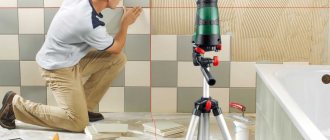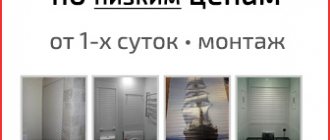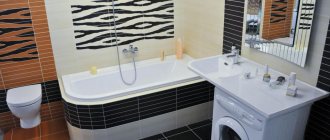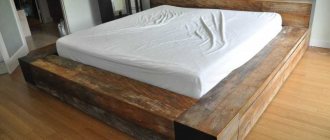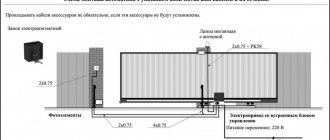Hello, my name is Marina. And I'm not a professional builder, but a designer. I want to say right away that, if possible, it is better not to mask old rusty pipes, but simply replace them. Moreover, the simplest heated towel rails can be bought for 1000-2000 rubles. And any man can handle the installation. But, of course, we don’t always find the money for this. Therefore, here are some tips that will help hide defects, for example, before guests arrive. But remember that this does not solve the problem.
Required knowledge
Taking into account the constant improvement of building materials, to hide bathroom pipes with your own hands, you do not have to be a master of engineering sciences; it is enough to have basic knowledge and all the necessary tools at hand.
Qualification comes with experience, but if you are doing repairs for yourself, the information you read will be quite enough to understand the principle of carrying out all the necessary work.
Why do you need an eccentric?
Heated towel rails with side connections usually have a center-to-center distance of within 50 cm. At first glance, it may seem that there is nothing easier to install a riser with the appropriate dimensions, but craftsmen often encounter deviations from a few millimeters to a couple of centimeters. If you purchased a heated towel rail with a side connection in the form of a coil, then the run-up can be a few millimeters; it usually does not play a big role. In addition, such a device can be compressed or expanded within acceptable limits.
But if you bought a ladder that has a rigid structure, you will no longer be able to separate the bends. Fortunately, eccentrics for heated towel rails are available for sale. Traditionally, these elements are used for installing wall-mounted mixers, but recently they have begun to produce those designed specifically for coils. They have a chrome plated finish and gaskets.
Before purchasing an eccentric for a heated towel rail, you need to make sure that it has the correct thread. You will need an element to mate it with the threads of the coil and the American tap on the bends. If the threads do not match, you can use the necessary adapters.
Preparatory procedures
Before hiding pipes in the bathroom, you should draw a project plan in order to understand the approximate location of all the elements and how much space the box will “eat up”.
You also need to take into account the placement of the door for access to the water supply taps, to the boiler adjustment (if there is one), and drains.
A detailed plan should reflect the possibility of opening furniture, a washing machine, and the ergonomic location of units, allowing a person to use the room comfortably.
When ordering materials, not only an accurate calculation is important, but also the ability to take more than required. It is better to overpay for an extra square meter of tiles than to discover there is a shortage after cutting them. The same applies to bulk mixtures, paint, profiles and bolts.
Using Bypass
In order for the system to function more efficiently, it provides for the installation of a bypass. It is a spare channel to which you can connect any equipment involved in heating. Its task is to ensure the functioning of the system when emergency situations occur in the connected components.
Usually, novice craftsmen do not think about the fact that leaks may occur. They fix the coils to the main pipes without installing shut-off valves. This approach during operation can cause a violation of the tightness of the connections and flooding of the room. This can have negative consequences if the room is located in a high-rise building with central heating.
When an emergency occurs, it may take a long time for the water supply to stop. Blocking and restoration work can leave part of the house without heat for an extended period of time. The bypass design is quite effective and simple, it allows you to gain confidence in the situation and not worry about the health of the equipment.
To carry out the work, you will need to create a kind of riser for the heated towel rail by installing tees at the ends of the pipes. Two directional outlets should be connected to a pipe. Side outlets are necessary for installing shut-off elements; pipes will be connected to them, which go to the heated towel rail.
When a structure is assembled from flexible ready-made connections, during its installation one should not forget about the use of sealing materials. When installing a plastic pipeline, you need to use a soldering iron. The master will need the help of one more person. When rigid connections are used for connection, you need to ensure compliance with the horizontal and vertical levels. Otherwise, the installed coil will not be able to be fixed evenly. Its incorrect position can ruin the entire impression of the repair.
Ease
If you decide to do the repairs yourself, it is worth considering that the materials should be lightweight. This will eliminate the need to use additional labor and assemble formwork from heavy raw materials.
For example, strong steel frames are necessary for attaching mirror or marble panels.
Resistance to moisture and temperature changes
When it comes to the bathroom, moisture resistance is the main indicator of the viability of a material. It is better to avoid chipboard-based coatings that are not marked “moisture resistant.”
Note!
IKEA bathroom: TOP-140 photos and videos of IKEA bathroom design options. Manufacturer's advantages. Features of the collectionsPVC panels for the bathroom: TOP-180 photos and video reviews. Advantages and disadvantages of the material. Varieties of PVC panel models. Mounting methods
Bathroom faucet: types of faucets and coating materials. Shower switch mechanism. Built-in and external mixers (photo + video)
Possibility of using cleaning agents
To prevent fungus and other pathogenic microorganisms from growing in the bathroom, compounds based on alcohol, bleach or acids are often used for cleaning.
It is worth understanding that the selected finishing material must be resistant to detergents and cleaning agents.
Installation of electric heated towel rails
The installation is carried out similarly to the wiring arrangement for any electrical equipment in the house. A groove is made for the three-core cable (groove). A wire is laid in it with fastening strips or buckles. It connects to a box with clamps. The blue conductor is neutral, the yellow-green conductor is grounding, the bright conductor is phase. The heated towel rail is grounded and connected to an RCD (residual current device) or differential circuit breaker. Install the socket. The cable is laid in corrugation.
Possibility of replacement
It’s nice to use exclusive materials, textures and colors to decorate a bathroom, but you should take care in advance about the possibility of replacing one or a couple of segments if they become deformed during installation or further use.
Before you hide the pipes in the bathroom in the wall, you should make sure that they are reliable. According to experts, there is no point in making a spectacular box if the communications themselves may soon require repairs.
Popular methods of masking communications
Speaking about the most practical ways of covering a bathroom, the leaders are the following:
Note!
Self-leveling floor in the bathroom - TOP 170 photo and video options. Advantages of self-leveling flooring in the bathroom. DIY pouring instructionsChest of drawers in the bathroom: 165 photos of stylish models and videos of current options for placing chests of drawers
- Sliding curtains for the bathroom - 165 photos + video instructions on how to choose and install sliding curtains correctly
- Finishing with plasterboard (the material allows you to choose a wide range of additional coatings and their textures, ranging from moisture-resistant wallpaper to tiles);
- Use of tiles;
- PVC panels;
- Sliding structures (shutters, blinds, blinds);
- Recessed communications wiring;
- Decorative materials.
Masking with plasterboard
Most photos of interiors showing how to hide pipes in the bathroom are based on a simple method of installing a box made of moisture-resistant plasterboard, and after decorating it with various materials, be it pasting with mosaics or textured wallpaper, painting or applying decorative plaster.
Assembly steps:
- Wall markings indicating the location of the profiles.
- The distance between the slats (aluminum profile) and the pipe must be at least 3 cm.
- The frame is attached to the wall and floor with dowels; at the corner joints, the slats are secured with metal corners to impart rigidity to the structure.
- If space allows, try to ensure that the frame is not located close to the tubes. If such areas exist, they need to be lined with reinforcing tape.
- Next, the sheet of drywall is cut into pieces corresponding in size to the edges of the box.
- The sheathing occurs using self-tapping screws, and the caps should be driven a couple of mm deep.
- One edge should be left for a technical hatch (later it can be designed as a cover, a ventilation duct, or a door, sliding or hinged).
- In the case of hot pipes, it is desirable to have a cutout for the ventilation grille so that heated air can freely enter the room.
Using the same principle, a plasterboard box can be used to hide the space under the bathroom.
Wrapping with fabric
An unattractive coil can be decorated with fabric. This method is suitable if it is not possible to replace worn out pipes in the near future.
Recent posts Soldering or crimping electrical wires Why is there humidity in the apartment and what to do Chopped at home: technical features and advantages
The main advantage of this method is that the fabric does not interfere with air circulation and the pipes retain their thermal characteristics.
When decorating with fabric, work is carried out in the following sequence:
- clean the heated towel rail from old paint;
- cut the fabric into strips 5–7 cm wide and tightly wrap the pipes in even turns;
- decorate with decorative elements: bows, large beads or stones.
The fabric can be used to cover not the entire pipe, but its individual sections. This decor looks like knots. It looks good on a pastel colored pipe.
In addition to fabric, you can use satin ribbon, twine, thick thick thread, or paper with a sticky layer.
It is not recommended to decorate the pipes of an electric heated towel rail with fabric strips, as they can cause overheating of the heating elements.
Tile
Since ceramics is one of the most practical materials for use in conditions of high humidity and temperature changes, the question of how to hide pipes in the bathroom under tiles is quite popular.
The step-by-step instructions for this process are as follows:
- As in the case of drywall, formwork should be made.
- Sew up the resulting frame with moisture-resistant plywood, chipboard (leaving a window under the technical hatch);
- A reinforcing mesh is glued to the chipboard;
- Next, you can lay the tiles.
- The last step is to grout the joints with anti-fungal putty.
Note!
Bathroom design 3 sq. m. - 115 photos and video description of how to decorate a bathroom in a stylish and original wayBathroom 6 sq. m.: 175 photos of practical ideas for applying bathroom design and video description of styling
- Bathroom lamps: 140 photos and video description of how to install beautiful and stylish lamps
Preparation
Procedural part
Replacing a heated towel rail is an ordinary task. Complications arise when the connection diagram and/or location is changed. In addition to technical ones, they solve organizational and legal issues. The system option determines the capabilities of residents:
- Individual autonomous heating allows work to be carried out without approval, at a time convenient for the owner.
- Connection to the heating supply (HS) of an apartment building limits replacement in the cold season without good reason: emergency leaks, lack of circulation.
- Connecting an apartment to the hot water supply (DHW) line allows for a temporary stop in water supply, but also requires contacting the management company.
It is impossible to independently turn off the vehicle, hot water supply, or drain the water in the second and third cases. Unauthorized actions can lead to air congestion, imbalance, and defrosting of the system. Flooding of the neighbors is possible; if the riser valve does not hold, you will have to shut off the supply to the entire house, which is dangerous in winter. You are responsible for the consequences.
The above is typical for Soviet standard panel series, where taps that cut off the dryer from the common branch were not installed. For example, the Khrushchev bathroom was equipped with a simple bent model, embedded directly into the heating pipe without a jumper.
New buildings usually have a bypass and taps in front of the towel, so you can repair or replace them without regard to your neighbors. In the absence of fittings, interaction with the management company will help to avoid problems:
- It is necessary to submit an application to the office of the Criminal Code with a request for permission to replace the heated towel rail in the bathroom. The document must be registered.
- Having received a positive response, contact the housing manager and agree on a time for the work.
- After the replacement is completed, a representative of the management company is invited to monitor compliance of the repair with the permit.
The algorithm involves the services of a third-party company. The service company can do it on its own, then the application asks to replace the water heated towel rail with a purchased new one, indicating the reason: the device is leaking and does not heat. It is easier to change the dryer in the summer during a major overhaul of the in-house networks; the cost of dismantling and installation is included in the mandatory payments for the overhaul.
The hired contractor must provide an extract from the Unified Register of SROs certifying the right to carry out the work. Those wishing to independently replace a leaky coil with a stainless steel sample or an ergonomic ladder will still have to negotiate with the housing department about shutting off the riser.
Note! In an apartment building, installing a jumper and shut-off valves, moving a device, changing a model, changing the connection method and diameters of the connections is not a reconstruction, since it does not require changes to the technical passport.
However, the listed actions change the design scheme of heat supply or hot water supply and affect network parameters, so approval of the engineering service of the management organization is necessary.
Often, the housing office offers to negotiate with the plumber privately, placing subsequent responsibility on the resident. You have the right to demand an official justified refusal with references to the standards.
To avoid discrepancies in the interpretation of articles of the housing code, study regional documents on the procedure for reconstruction. A few examples showing the interpretation of the term “reorganization”:
Remember! You cannot change it without permission. It is fraught with instructions to bring the diagram to its original form.
It is recommended to notify residents of the planned outage.
Technical events
Find out in advance from the senior building who holds the keys to the basement or attic to ensure access for repairmen. The linear fittings are closed by the personnel of the medical department or a specialized company.
If there is a dead-end DHW distribution, it is enough to turn off the apartment line. Circulation circuits require shutting off all risers included in the group.
A malfunction of the valves forces the building to be shut down; with an open heat supply circuit (hot water intake from the heating main), the valves are located in the elevator unit.
Connecting to a vehicle with bottom wiring requires shutting off the return and supply in the basement. The upper wiring allows you to cut off the branch by closing the taps on the roof and below.
Fitters empty the pipeline through drain fittings or plugs, usually into the sewer. The vehicle riser is drained at the top supply by opening the air vent on the roof; discharge at the bottom supply is accompanied by “hanging” water and the formation of air pockets.
The required volume of discharge depends on the type of wiring, floor, and is determined by plumbers. With a dead-end single-pipe distribution with a circulation riser, the descent can be done through the bathroom faucet.
Plastic panels (PVC)
The essence of finishing a bathroom with plastic panels is no different from the same work with drywall.
It is also necessary to construct formwork; the panels are attached with self-tapping screws along the edge, which are then covered with a decorative corner (it is usually glued with silicone).
Box of blinds
One of the interesting ways to hide communications. First you need to build a support for installation. The box should look like a unique version of a window.
To do this, a corresponding frame is built, which is sewn up with plastic, plywood for painting or plasterboard.
Next, the blinds are installed according to the instructions that come with them.
Which pipe elements should not be masked?
The operation of the system is not immune to failures. To repair pipelines, inspection hatches are left to provide access to elements where problems may occur. These include places:
Metal pipes can be completely covered under tiles.
- with threaded connections, taps;
- with fittings that need to be tightened;
- corner type connections, tees, crosses, where there is a high probability of leakage;
- where counters and filters are installed.
Metal or plastic pipes without threaded or welded joints can be completely covered under plaster or tiles. Then the likelihood of a leak is reduced to zero, and you won’t have to break down the walls to fix the problem.
Radical methods
If the question of hiding pipes in the bathroom is raised at the construction stage, it is possible to recess the pipes in the walls. The disadvantage of this method is the subsequent inability to quickly access communications.
False walls
This design hides not only pipes, but also possible defects in the main wall. This technique does not spoil, but rather greatly enlivens the bathroom interior, creating three-dimensionality and a constructive accent. The only thing you have to put up with is that the false wall will take up at least 30 cm of free space.
Inside the device you can install shelves for storage, niches for a toilet adjacent to the wall, viewing windows for meters, doors for functional units. The decoration of the false wall will match the overall tone of the room.
Decoration
A creative approach to decorating communications is the most financially accessible method of hiding them.
- Winding with jute (the end of the thread must be fixed or secured with silicone).
- Cover the pipe with a cardboard tube, and then cover it with moisture-resistant self-adhesive film “like wood” or another texture.
As can be seen from the above methods, the process of upgrading a bathroom and hiding pipes and other unsightly elements is not work that requires large financial or labor costs.
By following these simple instructions, you can make your interior modern and attractive, without the help of expensive construction teams.
Hiding the pipeline in the floor
Speaking about methods of placing communications, it is worth remembering another interesting method. You can close it in the floor.
This solution to the problem is attractive because it does not require gating. The pipes are laid on the floor slab and secured. After this, the screed is poured.
The disadvantage of this method is that sewer pipelines cannot be hidden in the floor. They will have to be laid using the usual old method - in grooves.
